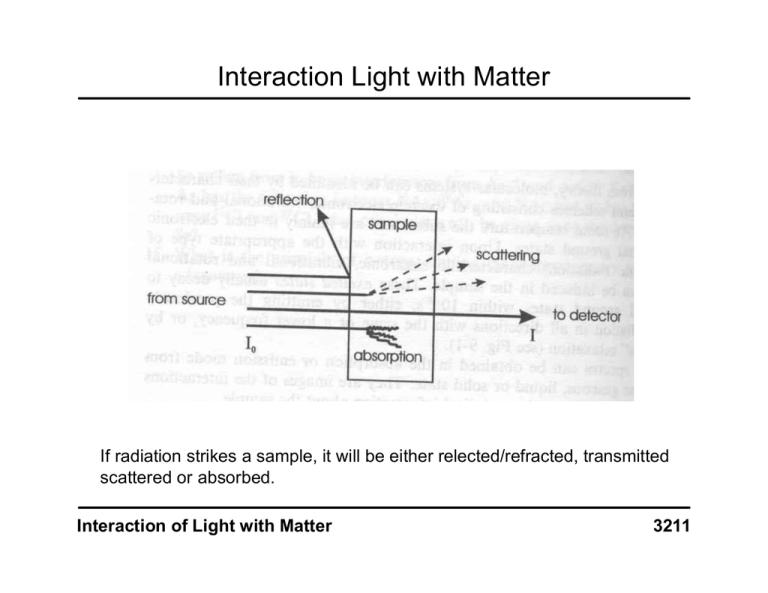Interaction Light with Matter
advertisement

Interaction Light with Matter If radiation strikes a sample, it will be either relected/refracted, transmitted scattered or absorbed. Interaction of Light with Matter 3211 Transmission The speed of light transmitted through a transparent (molecularly dispers) medium is usually dependent on the interaction of the radiation with the atoms, ions or molecules in the medium. Refractive index: ni = c/ν i Ø No change of frequency Ø No permanent energy transfer between radiation and species What happens? A periodical polarization of the atoms, ions or molecules present in the medium. Simplified → a periodical deformation of the electron cloud surrounding the respective species. ⇒ Only the propagation speed of the radiation is reduced depending on the properties of the transmission medium. νi = ν λ i → ni = c/νλ i Since c is constant, the refractive index of the substance is de pendent on the wavelength of the radiation → DISPERSION Interaction of Light with Matter 3211 Dispersion This dependence of the refractive index on the wavelength and frequency is called dispersion, which is a complex function. Ø Normal dispersion: Considering non-polarized light transmitting a medium with molecules, usually the refractive index increases continuously with increasing frequency. Ø Anomalous dispersion: If strong absorption of light due to electronic, rotational or vibrational excitation of these molecules and thus energy transfer occurs, areas of discontinuity appear around these absorption lines. Interaction of Light with Matter 3211 Reflection and Refraction 1 If radiation hits an interface between two media with different refractive index, reflection occurs at the interface. With increased refractive index difference an increased amount of the incident radiation will be reflected. Ir/I0 = (n2-n1)2/(n2 +n1)2 Refraction occurs additionally at an interface of vacuum (air) and a weakly absorbing medium with different refractive indices n1 and n2 as an abrupt change of the propagation direction of the light propagating into the second medium. Snell’s law: sinθ1/sin θ2 = n2/n1 Interaction of Light with Matter 3211 Reflection and Refraction 2 The law of reflection/refraction cannot describe the change of intensity and polarization at a reflection/refraction event. Fresnel’s equations describe the reflection behavior in dependence of the angle of incidence from non-absorbing to strongly absorbing media. The energy of an electromagentic wave is defined by ε*E2 with ε representing the dielectric constant. The reflectivity of a surface is defined by: R = Er2/Ei 2 Ratio of amplitudes Er/Ei Air-Glass Air-Steel Angle of incidence Angle of incidence Interaction of Light with Matter The reflection behavior is strongly dependent on the polarization of the radiation. The angle ϕp, where parallel polarized light is not reflected at all is called Brewster angle. Since ni = tan ϕp the refractive index can be determined by measuring the Brewster angle. 3211 Scattering Scattering of radiation may occur during a transmission process in a nonhomogeneous medium, containing large particles (e.g. aggregates of molecules or ions, polymers, colloids, etc.), causing reemission of the light without preferential propagation direction. Ø Rayleigh scattering: Occurs at particles or aggregates of particles with a size significantly smaller than the wavelength of the interrogating radiation (IRayleigh = 1/λ 4). (Example: Blue sky) Ø Scattering by large molecules/aggregates: Large molecules/aggregates such as colloidal systems, with a size in the order of magnitude of the incident radiation or larger, cause scattering at intensities high enough to be visible with the human eye. (Example: Tyndall effect) Ø Raman scattering: In contrast to the previously described scattering effects, Rama n scattering is accompanied by a quantized frequency shift of part of the scattered radiation due to transitions between vibrational states occurring in molecules as a result of the polarization processes. This results in Stokes/Anti-Stokes Raman lines next to the Rayleigh peak and is used analytically in Raman spectroscopy. Interaction of Light with Matter 3211 Polarization Polarization describes the vibrational plane of an electromagnetic wave. Simplified → non-polarized radiation can be described as a bundle of electromagnetic waves/rays with its vibrational modes distributed homogeneously among an infinite number of vibrational planes centered along the propagation axis of the wave/ray. In an arbitrary plane, each vector is defined by two perpendicular components. By combination of all these components of all vibrational planes, two resulting perpendicular planes remain along the propagation axis of the ray. Removing one of these planes results in linearly polarized radiation with an electrical vector vibrating in a single vibrational plane between 0 and A. Interaction of Light with Matter 3211 Diffraction Diffraction describes the effect that a collimated beam of electromagnetic radiation passing through a narrow opening (in comparison to the wavelength of the radiation) is bent. This principle applies for all types of electromagnetic radiation and even for acoustic or mechanic waves. Interaction of Light with Matter 3211







